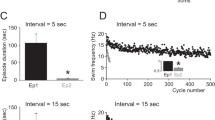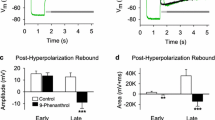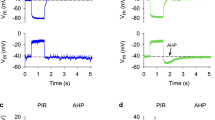Abstract
The K+-agitated (Kag) mutant of Paramecium caudatum shows prolonged backward swimming in K+-rich solution. To understand the regulation mechanisms of the ciliary motility in P. caudatum, we examined the membrane electrical properties of the Kag mutant. The duration of the backward swimming of the Kag in K+-rich solution was about 10 times longer than that of the wild type. In response to an injection of the outward current, the wild type produced an initial action potential and a subsequent membrane depolarization due to I-R potential drop, while the Kag exhibited repetitive action potentials during the depolarization. Under voltage-clamp conditions, the depolarization-activated transient inward current exhibited by the Kag was slightly smaller than that exhibited by the wild type. In response to an application of K+-rich solution, both the wild type and the Kag exhibited a depolarizing afterpotential representing the activation of the K+-induced Ca2+ conductance. The inactivation time course of the K+-induced Ca2+ conductance of Kag was about 10 times longer than that of the wild type. This difference corresponds well with the difference in behavioral responses between Kag and wild type to K+-rich solution. We conclude that the overreaction of the Kag mutant to the K+-rich solution is caused by slowing down of the inactivation of the K+-induced Ca2+ conductance.







Similar content being viewed by others
References
P. Brehm R. Eckert (1978) ArticleTitleCalcium entry leads to inactivation of calcium channels in Paramecium. Science 202 1203–1206 Occurrence Handle1:CAS:528:DyaE1MXltFaisg%3D%3D Occurrence Handle103199
R. Eckert (1972) ArticleTitleBioelectric control of ciliary activity. Science 176 173–481 Occurrence Handle4335386
T.M. Hennessey C. Kung (1985) ArticleTitleSlow inactivation of the calcium current of Paramecium is dependent on voltage and not internal calcium. J. Physiol. 365 165–179 Occurrence Handle1:CAS:528:DyaL2MXkvVCksbs%3D Occurrence Handle2411920
T.M. Hennessey C. Kung (1987) ArticleTitleElectrophysiological evidence suggests a defective Ca2+ control mechanism in a new Paramecium mutant. J. Membrane Biol. 98 275–283
T.M. Hennessey L.E. Frego J.T. Francis (1994) ArticleTitleOxidants act as chemorepellents in Paramecium by stimulating an electrogenic plasma membrane reductase activity. J. Comp. Physiol. A 175 655–665 Occurrence Handle1:STN:280:ByqD2MrjtFE%3D Occurrence Handle7965925
T.M. Hennessey M.Y. Kim B.H. Satir (1995) ArticleTitleLysozyme acts as a chemorepellent and secretagogue in Paramecium by activating a novel receptor-operated Ca++ conductance. J. Membrane Biol. 148 13–25 Occurrence Handle1:CAS:528:DyaK2MXpsVejtLo%3D
R.D. Hinrichsen Y. Saimi (1984) ArticleTitleA mutation that alters properties of the calcium channel in Paramecium tetraurelia. J. Physiol. 351 397–410 Occurrence Handle1:CAS:528:DyaL2cXktVelt78%3D Occurrence Handle6086904
J.A. Kink R.E. Maley R.R. Preston K.-Y. Ling M.A. Warren-Friedman Y. Saimi C. Kung (1990) ArticleTitleMutations in Paramecium calmodulin indicate functional difference between the C-terminal and N-terminal lobes in vivo. Cell 62 165–174 Occurrence Handle1:CAS:528:DyaK3MXhsVCj Occurrence Handle2163766
C. Kung (1971a) ArticleTitleGenic mutations with altered system of excitation in Paramecium aurelia. II. Mutagenesis, screening and genetic analysis of the mutants. Genetics 69 29–45 Occurrence Handle1:STN:280:CS2D2sjpsFA%3D
C. Kung (1971b) ArticleTitleGenic mutations with altered system of excitation in Paramecium aurelia. I. Phenotypes of the behavioural mutants. Z. Vergl. Physiol. 71 142–164
Y. Naitoh (1968) ArticleTitleIonic control of the reversal response of cilia in Paramecium caudatum. J. Gen. Physiol. 51 85–103 Occurrence Handle1:CAS:528:DyaF1cXns1Shtw%3D%3D Occurrence Handle4966766
Y. Naitoh (1974) ArticleTitleBioelectric basis of behavior in protozoa. Am. Zool. 14 883–893 Occurrence Handle1:CAS:528:DyaE2MXktVCmtQ%3D%3D
Y. Naitoh R. Eckert (1969) ArticleTitleIonic mechanisms controlling behavioral responses of Paramecium to mechanical stimulation. Science 164 963–965 Occurrence Handle1:CAS:528:DyaF1MXktlKmt78%3D Occurrence Handle5768366
Y. Naitoh H. Kaneko (1972) ArticleTitleReactivated Triton-extracted models of Paramecium: Modification of ciliary movement by calcium ions. Science 176 523–524 Occurrence Handle1:CAS:528:DyaE38XktVaksb4%3D Occurrence Handle5032354
K. Oami (1996a) ArticleTitleMembrane potential responses controlling chemodispersal of Paramecium caudatum from quinine. J. Comp. Physiol. A 178 307–316
K. Oami (1996b) ArticleTitleDistribution of chemoreceptors to quinine on the cell surface of Paramecium caudatum. J. Comp. Physiol. A 179 345–352 Occurrence Handle1:CAS:528:DyaK2sXjtlahur0%3D
K. Oami (1998a) ArticleTitleMembrane potential responses of Paramecium caudatum to bitter substances: existence of multiple pathways for bitter responses. J. Exp. Biol. 201 13–20 Occurrence Handle1:CAS:528:DyaK1cXpsFKmsg%3D%3D
K. Oami (1998b) ArticleTitleIonic mechanisms of depolarizing and hyperpolarizing quinine receptor potentials in Paramecium caudatum. J. Comp. Physiol. A 182 403–409 Occurrence Handle1:CAS:528:DyaK1cXisVCntb4%3D
K. Oami M. Takahashi (1998) ArticleTitleMembrane potential responses to K+ stimulation and membrane electric characteristics of the K+-agitated mutant of Paramecium caudatum. Zool. Sci. 15 Supplement 103
K. Oami M. Takahashi (2002) ArticleTitleIdentification of the Ca2+ conductance responsible for K+-induced backward swimming in Paramecium caudatum. J. Membrane Biol. 190 159–165 Occurrence Handle1:CAS:528:DC%2BD38XpsV2iur4%3D
R.R. Preston J.A. Hammond (1998) ArticleTitleCa2+ current-deficient Pawn mutants are promoted to queens during chronic depolarization of Paramecium tetraurelia. J. Membrane Biol. 171 245–253 Occurrence Handle10.1007/s002329900575
R. Ramanathan Y. Saimi R. Hinrichsen A. Burgess-Cassler C. Kung (1988) A genetic dissection of the ion channel functions. H.D. Goertz (Eds) Paramecium. Springer-Verlag New York 236–253
Y. Saimi C. Kung (1980) ArticleTitleA Ca-induced Na+ current in Paramecium. J. Exp. Biol. 88 305–325 Occurrence Handle1:CAS:528:DyaL3MXmtFeqtg%3D%3D Occurrence Handle7452141
Y Saimi C. Kung (1994) ArticleTitleIon channel regulation by calmodulin binding. FEBS Letters 350 155–158 Occurrence Handle10.1016/0014-5793(94)00782-9 Occurrence Handle1:CAS:528:DyaK2cXmslCmtr4%3D Occurrence Handle8070555
M. Takahashi (1979) ArticleTitleBehavioral mutants in Paramecium caudatum. Genetics 91 393–408 Occurrence Handle1:CAS:528:DyaE1MXktFKmsL8%3D
M. Takahashi (1988) Behavioral genetics in P. caudatum. H.D. Goertz (Eds) Paramecium. Springer-Verlag New York 271–281
M. Takahashi N. Haga T. Hennessey R.D. Hinrichsen R. Hara (1985) ArticleTitleA gamma ray induced non-excitable membrane mutant in Paramecium caudatum: a behavioral and genetic analysis. Genet. Res. Camb. 46 1–10 Occurrence Handle1:STN:280:BimD2MnptlE%3D
M. Takahashi Y. Naitoh (1978) ArticleTitleBehavioral mutants of Paramecium caudatum with defective membrane electrogenesis. Nature 271 656–658 Occurrence Handle1:STN:280:CSeC3Mvgslc%3D Occurrence Handle625333
J. Van Houten (1992) ArticleTitleChemosensory transduction in eucaryotic microorganisms. Annu. Rev. Physiol. 54 639–663 Occurrence Handle1:CAS:528:DyaK38XisFWksLs%3D Occurrence Handle1562186
Acknowledgements
This work was supported by a grant from the Ministry of Sports, Culture, Science, and Education of Japan (09640802) and a research project of the University of Tsukuba.
Author information
Authors and Affiliations
Corresponding author
Rights and permissions
About this article
Cite this article
Oami, K., Takahashi, M. K+-induced Ca2+ Conductance Responsible for the Prolonged Backward Swimming in K+-agitated Mutant of Paramecium caudatum . J. Membrane Biol. 195, 85–92 (2003). https://doi.org/10.1007/s00232-003-2047-3
Received:
Issue Date:
DOI: https://doi.org/10.1007/s00232-003-2047-3




